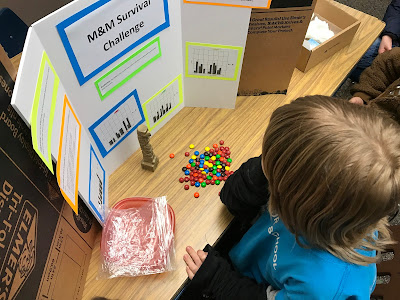As a life-long bird watcher myself (thanks to my mom!) I could teach about birds all year long and never run out of things to do. But since that's not possible, I'll include a list of things to do and places to go in the Puget Sound area so that you and your child can learn more and perhaps become life-long birders as well.
Here are some of the things we did in class:
BEAKS
We played a game called "Busy Beaks" in which we were given one minute to to pick up a variety of "food" with a variety of "beaks". We discovered that different types of birds have different types of beaks that eat different types of food.
The "food" included seeds/cheerios, pipe-cleaners, jelly beans and raisins.
The "beaks" included spoons, toothpicks, tweezers and clothespins.
We recorded our findings.
We made graphs using
Create-a-Graph. Notice the labels each student chose to use.
FEATHERS
We looked at feathers up close under a microscope.
Lots of oohs and ahs.
We read a book about feathers and learned about the different types and purposes of feathers.
We personalized a readers theater script called "Feathers."
We made our own costumes in the MakerSpace.
A swan:
A red-tailed hawk
We practiced and practiced and then presented our readers theater to our schoolmates at Gathering.
Not the best picture, but notice the sled for a penguin and the snowshoes for the ptarmigan. We learned a lot about feathers and came up with some great ways to show our friends.
She was also a peacock.
JOHN JAMES AUDUBON
We learned about a boy with a passion, John James Audubon.

We watercolor painted our own birds (and did a mighty fine job, I might add.)
Other things to do in the Puget Sound area:
Get a bird book and keep it in your glove box! And keep an ongoing list. Or start a contest to see who can have the longest list.
Bird Cams:
Local Browns Point eagle nest:
Walk down Varco Road. It's almost at the end of the road. Be respectful of neighbors and stay on the road.
Annual Migration
May 5-7, 2017
from the webpage:
Each spring, hundreds of thousands of shorebirds stop to rest and feed along the Washington Coast and in the Grays Harbor estuary during their migration northward. Coming from as far south as Argentina, these Arctic-bound shorebirds are among the world's greatest migrants. Some birds travel over 15,000 miles round trip! The concentration of birds during spring migration offers people a great chance to view a number of shorebird species. With luck you will also see the birds fly together in beautiful formations while trying to escape a Peregrine Falcon.
Heron Rookery in Renton
from the webpage:
The Black River Riparian Forest and Wetland is home to more than 50 species of birds, including one of the largest great blue heron colonies in the region. The site is a complex ecosystem with an abundant wildlife habitat. The Black River Riparian Forest and Wetland is a year-round bird watcher's paradise and provides an oasis and a unique view of nature within Renton's city limits.
Other bird spotting locations:
- Point Defiance Park Outer Loop
- Commencement Bay Trail
- Wapato Lake Trail
- Titlow Park
- Owen Beach Trail
- Bresemann Forest Trail
- Snake Lake Loop Trail--great place for wood ducks
- War Memorial Park to Tacoma Narrows Bridge
Others:
- Weyerhauser headquarters has great trails (just pretend that the sound of I-5 is the ocean)
- Hylebos Park in Federal Way
- Mount Rainier
- Nisqually National Wildlife Refuge
- Olympic National Park area (I saw an albino robin there once!)
Tahoma Audubon: Lots of good resources including the Adriana Hess Aububon Center, monthly classes and activities, an art contest (http://www.tahomaaudubon.org/kids), field trips and more.






























































